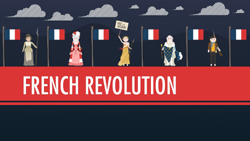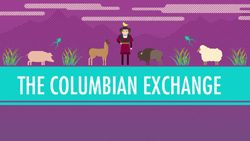-
The Industrial Revolution changed the way people lived and
worked.
During the late eighteenth century, the Industrial Revolution
began in Great Britain. An agrarian revolution and industrialization
caused a shift from an economy based on farming and handicrafts to an economy
based on manufacturing by machines in factories.
The Industrial Revolution in Great Britain
-
With its plentiful natural resources, workers, wealth, and
markets, Great Britain became the starting place of the Industrial Revolution
The Industrial Revolution begain in the Kingdom of Great
Britain in the 1780's.
Several factors led to Great Britain being the starting
place for the Industrial Revolution:
First, an agrarian revolution took place in the eighteenth
century that changed agricultural practices. The amount of available
farmland increased and transportation improved. New crops, such as
the potato, dramatically increased the food supply. And the century
saw good weather across the islands.
More people could be feed at lower prices with less labor.
Second, with increased food supply came incresed population.
enclosure movement
In Great Britain, during the 1700ís, the Parliamentary
decree that allowed fencing off of common lands, forcing many peasants
to move to town
Because of the enclosure movement, there was a migration
from farms and rural areas to towns, increasing urban populations.
Large urba poulations created a ready labor supply for
factories.
The farms that remained were larger, more efficient, and
saw increased crop yields.
Third, the Kingdom had a ready supply of capital.
capital
Money available for investments
Private citizens could afford to invest in factories and
new machines.
entrepreneur
A person interested in finding new business opportunities
and new ways to make profits
Entrepreneurs found new ways to profit in the new laissez-faire,
free-market economy, ruled by supply and demand, with little government
intervention.
Fourth, Great Britain had plentiful natural resources
that proved useful to industry. The islands' rivers provided not
only the power for the new factories, but also a means to transport raw
materials and finished products.
England, Wales, Scotland, and Ireland also had abundant
supplies of coal, iron, and tin.
And fifth, the United Kingdom of Great Britain provided
their manufacturers a vast supply of markets, giving factories many outlets
for their goods.
The United Kingdom contolled a world-wide colonial empire,
and her ships could transport its goods anywhere in the world.
And because of cheaper food and population growth, Britain's
domestic markets increased.
Growing demand led to a need for increased production.
Changes in Cotton Production
The manufacture of cotton cloth moved from cottage industries
to factories
In the 1700's, the manufacture of cotton cloth was a two-step
process: First, raw cotton was spun into thread. Second, cotton
threads were woven into cloth on looms operated by a single person.
Spinning and weaving were both done by individuals in
their own rural homes.
cottage industry
a method of production in which tasks are done by individuals
in their rural homes
The cottage industry in Britain was in competition with
the cheaper cotton industry in India, which was also a part of the empire.
Technological advances brought the industry out of the
individual cottage and into large factories.
The invention of the "flying shuttle" made weaving faster.
Now, more thread was needed.
In 1764, James Hargraves invented the "spinning jenny,"
which could spin cotton into thread so fast, that the weavers could not
keep up.
In 1787, Edmund Cartwright invented a water-powered loom
that could use the surplus of thread.
These new machines exceeded the capacity of single homes,
and workers began to be brought in to the machines. Workers lived
close to the factories, which were originally built near the the streams
and rivers which powered them.
The textile industry met its last major challenge to full
mechanization with the development of the steam engine.
James Watt
A Scottish engineer, who, by 1782, had invented and improved
upon a funtional steam engine that could drive machinery, such as those
that could be used to spin and weave cotton.
Because they were coal powered, the factories no longer
needed to be located near rivers. Before long, steam-powered cotton
mills were found all over Great Britain.
The spread of the factory system resulted in increased
exports of British cotton goods.
The efficiency and quantity of the domestic cotton industry
destroyed the cotton cottage industry of India. Their British overlords
encouraged. agricultural development and neglected industrial development
in India.
The Coal and Iron Industries
Coal was needed to fuel the new steam engines.
High quality iron was needed to build the new machines,
especially trains.
puddling
Puddling was a process in which coke derived from coal
was used to burn away impurities in crude iron to produce high quality
iron; this method was developed in the 1780's by Henry Cort.
The New Factories
Made use of the new steam-driven machinery; workers worked
in shifts in order to keep the machinery in constant use
Railroads
Used steam-powered locomotives to move resources and
goods across country
Manchester
A cotton-manufacturing town in England
Liverpool
A thriving sea-port in England
Industrialization Transforms Society
The Industrial Revolution in Europe began the shift from
an agricultural to an industrial economy. Starting in Great Britain,
it transformed not only where people worked but also the nature of work
itself.
|
Social Changes of Industrialization
|
Before the Industrial Revolution
-
Agricultural work on farms and in homes predominated; cottage
industry took place in homes.
-
Most people lived in rural areas.
-
Single workers or families produced an entire product.
|
During and After the Industrial Revolution
-
Manufacturing predominated, with workers placed in factories;
cottage industry declined or disappeared.
-
Workers migrated to work in city factories, causing explosive
growth, overcrowding, and filthy conditions.
-
Factories practiced division of labor. Each worker
performed one task in the production process. These tasks were often
repetitive and boring.
-
Factory work required long hours under harsh working conditions.
-
Child labor, which included children as young as seven years
old, occurred on a large scale. Women and children were usually paid
lower wages.
|
The steam engine was the most important innovation of
the Industrial Revolution because it transformed both farm production and
the transportation system.
REVIEW & DO
NOW
Answer the following questions in your spiral notebooks: |
| . |
. |
|
|
The Spread of Industrialization
-
The pace of industrialization in Europe and the United States
depended on many factors, including government policy.
Europe
From Great Britain, industrialization spread to Belgium,
France, and the German states, as governments actively encouraged industrialization
and provided funds to build roads, canals, and railroads.
North America
In 1800, five million people lived in the US, and 6 out
of 7 people lived on a farm. By 1860, the population had grown to
30 million people, and only 50 percent of the people were farmers.
Robert Fulton
Built the first paddle-wheeled steamboat, the Clermont,
in 1807
REVIEW & DO
NOW
Answer the following questions in your spiral notebooks: |
| . |
. |
|
|
Social Impact in Europe
-
Industrialization urbanized Europe and created new social
classes, as well as the conditions for the rise of socialism.
Population and Urban Growth
The Industrial Middle Class
industrial capitalism
An economic system based on industrial production or
manufacturing
Industrial Capitalism rose during the Industrial Revolution
and produced an industrial middle class.
In the Middle Ages, the bourgeoisie was
the burgher, or town-dweller. They were merchants, government officials,
artisans, or intellectuals. Later, the bourgeois came to include
industry and banking, as well as professionals such as doctors, lawyers,
and teachers.
The new industrial middle class was made up the factory
owners-- the men who had enough money to build factories, buy the machines,
or develop the markets where the goods were sold.
They had ambition, drive, and a strong desire to make
as much money as they possibly could.
The accumulation of monetary wealth soon became a pursuit
in and of itself.
The Industrial Working Class
The lives of factory workers was wretched. They
were not much better than slaves, paid not much more than starvation wages.
Entire families were drafted into factory work, including
children as young as seven.
Days were 14 and 16 hours long, with no breaks and no
lunches, locked up indoors in the heat, and unable to leave.
Early Socialism
socialism
A system in which society, usually in the form of the
government, owns and controls the means of production
Robert Owen
A British cotton manufacturer and utopian socialist who
believed that humans would show their natural goodness if they lived in
a cooperative environment
Under socialism, with its public ownership of the means
of production, where the workers owned the factories the worked at and
benefited in the profits the factories earned, was meant to result
in an equitable distribution of wealth.
REVIEW & DO
NOW
Answer the following questions in your spiral notebooks: |
| . |
. |
|
|
|





